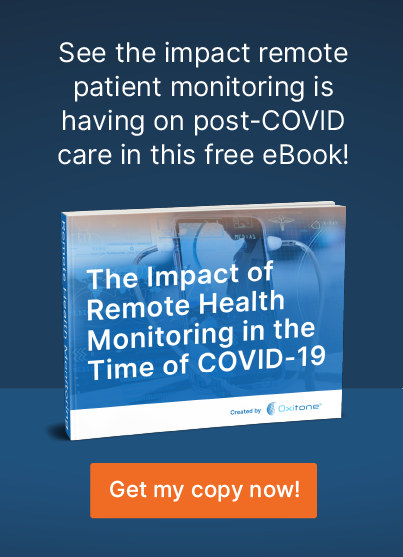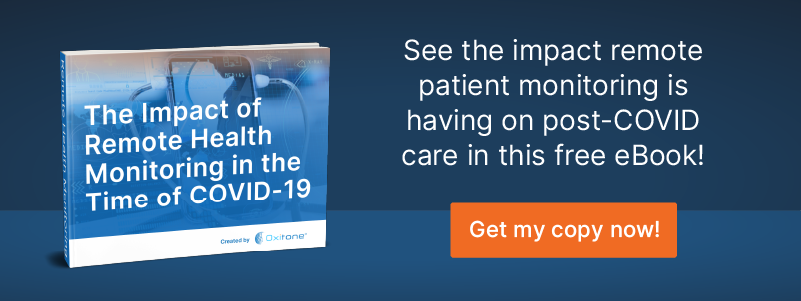COVID-19 effectively wrecked the global health sector. Even countries with advanced medical infrastructures struggled to cope with the surge of new patients. The fact that COVID is especially lethal for people with pre-existing conditions further complicated things. In this article, we discuss how continuous remote patient monitoring (CRPM) improved patient care during the pandemic.
Managing chronic patients: A major healthcare challenge
Medical workers and caregivers had to minimize their exposure while ensuring an adequate level of care for their patients. The traditional remote patient monitoring (RPM) frameworks were applied and proved to be effective, but they heavily relied on patient compliance and the availability of caregivers. Both of these were hard to ensure even before the pandemic. Moreover, patients with serious chronic conditions needed regular checkups, which standard RPM couldn’t facilitate.
This was a perfect opportunity to field-test CRPM systems. These filled the gap left by RPM and created new opportunities for healthcare workers to enhance the level of patient care.
Let’s look at five cases in which CRPM played a significant role in making the jobs of healthcare workers easier.
Case 1: Effective management of chronic patients
From the start, it was apparent that pre-existing conditions like COPD and cardiovascular issues increased the likelihood of COVID complications. This meant that patients who visited hospitals regularly or were admitted for long-term care were at the greatest risk.
The proximity of doctors with COVID patients meant that they could expose their other patients to the virus, something likely to happen without CRPM.
Most chronic conditions require doctors to keep an eye on certain parameters (heart variability, pulse rate, etc.) and maintain them in certain intervals. Doctors could minimize their patient’s exposure to the virus by keeping them isolated in their homes and intervening only when necessary.
Not only was this approach beneficial for the safety of the patients, but it also allowed healthcare workers to devote more resources to the treatment of COVID patients, which was more pressing and required an all-hands-on-deck approach.
Case 2: Reducing the overall burden on COVID wards
Even with all the precautions and specialized COVID facilities, the sheer number of patients was too much for the medical industry to handle. In the United States alone, more than 32 million people were infected with COVID. Moreover, regular procedures—albeit to a small extent—were still taking place because other medical situations didn’t just stop because COVID was around.
So, the medical infrastructure was under enormous pressure.
It was extremely fortunate that a large number of COVID patients could be effectively managed from the isolation of their homes. However, it was still necessary to monitor multiple key parameters of those patients because COVID can quickly affect organs like the lungs, heart, kidneys, etc.
Wearable medical devices, such as the Oxitone 1000M, were excellent in this case. They had multi-parameter monitoring capability and continuously tracked the respiratory rate, blood oxygen level, and other parameters automatically. This way, doctors could keep an eye on COVID patients in their homes and reduce the overall burden on the hospitals.
Case 3: Helping doctors understand the long-lasting effects of COVID
COVID-19 is a novel disease, so effective management is not the only concern for doctors. They need enough data about the short-term and long-term effects of the disease to understand it better and prepare for any similar outbreaks in the future.
Continuous remote monitoring and artificial intelligence (AI) analytics can be a great help in this regard. The technology can give doctors the valuable research data that they need to develop countermeasures, like the appropriate medicines and vaccines.
Case 4: Improved patient compliance
Non-compliance is a significant problem for the medical sector as a whole, not specifically for COVID treatment. It has financial, medical, and legal consequences and can seriously complicate many non-threatening conditions.
Traditionally, doctors relied on a hybrid system of caretakers, family members, and technology to improve patient compliance.
However, due to COVID, they cannot encourage unnecessary exposure to the virus and put a patient at risk. In this scenario, CRPM can help doctors keep an eye on their patients.
In most chronic cases, not adhering to specific orders can immediately affect common parameters like BP, blood sugar, oxygen levels, etc. Through effective multi-parameter monitoring, doctors can reduce overall complications due to non-compliance. Combined with AI, CRPM tech can also be used to remind patients to take their medicines, do the required exercises, and perform other actions deemed necessary by the doctor.
Case 5: Enhancement in the quality of life for patients
Another area where CRPM shined was in enhancing the overall life quality of patients. COVID often only presents itself in the form of mild symptoms, but the fear of this virus can lead to anxiety and other mental health issues.
Research indicates that having a positive outlook and recovery have a direct relationship. For many people, independence to lead their lives as they see fit in their homes can significantly affect their rate of recovery. This is not a COVID-only phenomenon. Most chronic patients respond better to treatment when they are at home rather than in a care facility.
CRPM can provide that independence without any risks. Rather than being hooked to a machine, they can wear wearable medical tech to keep an eye on their condition and inform doctors immediately in case of an issue. This gives peace of mind to patients and their families alike.
Using AI and continuous remote patient monitoring to improve patient handling with Oxitone
The pandemic tested the limits of CRPM and AI in the medical sector. Machine learning and other similar technologies are no longer the future of healthcare. They are here and continue to improve the way that we handle patients every day.
Oxitone, with its integrated AI solutions and wearable devices, can help you navigate the dynamic landscape of the healthcare industry. To learn more about how Oxitone’s solutions are helping doctors and patients, check out our clinical studies.
Here at Oxitone, we boost value-based healthcare by delivering extraordinary patient, clinical, and economical outcomes at reduced medical utilization and cost. Patients need a prompt response to emergencies. Physicians need an easy and timely follow-up with patients. Our mission is to transform chronic disease management and help save lives worldwide.
Let’s save lives together! To see how we help remote patient monitoring companies and physicians improve the management and care of high-risk patients, contact us today!


